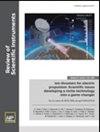XUV-beamline for photoelectron imaging spectroscopy with shaped pulses
IF 1.3
4区 工程技术
Q3 INSTRUMENTS & INSTRUMENTATION
引用次数: 0
Abstract
We introduce an extreme ultraviolet (XUV)-beamline designed for the time-resolved investigation and coherent control of attosecond (as) electron dynamics in atoms and molecules by polarization-shaped as-laser pulses. Shaped as-pulses are generated through high-harmonic generation (HHG) of tailored white-light supercontinua (WLS) in noble gases. The interaction of shaped as-pulses with the sample is studied using velocity map imaging (VMI) techniques to achieve the differential detection of photoelectron wave packets. The instrument consists of the WLS-beamline, which includes a hollow-core fiber compressor and a home-built 4f polarization pulse shaper, and the high-vacuum XUV-beamline, which combines an HHG-stage and a versatile multi-experiment vacuum chamber equipped with a home-built VMI spectrometer. The VMI spectrometer allows the detection of photoelectron wave packets from both the multiphoton ionization (MPI) of atomic or molecular samples by the tailored WLS-pulses and the single-photon ionization (SPI) by the shaped XUV-pulses. To characterize the VMI spectrometer, we studied the MPI of xenon atoms by linearly polarized WLS pulses. To validate the interplay of these components, we conducted experiments on the SPI of xenon atoms with linearly polarized XUV-pulses. Our results include the reconstruction of the 3D photoelectron momentum distribution (PMD) and initial findings on the coherent control of the PMD by tuning the spectrum of the XUV-pulses with the spectral phase of the WLS. Our results demonstrate the performance of the entire instrument for HHG-based photoelectron imaging spectroscopy with prototypical shaped pulses. Perspectively, we will employ polarization-tailored WLS-pulses to generate polarization-shaped as-pulses.利用异形脉冲进行光电子成像光谱分析的 XUV 光束线
我们介绍了一种极紫外(XUV)光束线,旨在通过偏振形激光脉冲对原子和分子中的阿秒(as)电子动力学进行时间分辨研究和相干控制。形如脉冲是通过惰性气体中定制白光超连续体(WLS)的高谐波发生(HHG)产生的。利用速度图成像(VMI)技术来研究异形激光脉冲与样品的相互作用,从而实现对光电子波包的差分探测。该仪器由 WLS 光束线和高真空 XUV 光束线组成,前者包括一个中空芯光纤压缩器和一个自制的 4f 偏振脉冲整形器,后者结合了一个 HHG 平台和一个多功能多实验真空室,并配备了一个自制的 VMI 光谱仪。VMI 光谱仪可以检测原子或分子样品在定制 WLS 脉冲作用下发生多光子电离(MPI)和在成型 XUV 脉冲作用下发生单光子电离(SPI)所产生的光电子波包。为了确定 VMI 光谱仪的特性,我们研究了线性偏振 WLS 脉冲对氙原子的 MPI。为了验证这些组件之间的相互作用,我们利用线性偏振 XUV 脉冲对氙原子的 SPI 进行了实验。我们的研究结果包括三维光电子动量分布(PMD)的重建,以及通过调整 XUV 脉冲的光谱与 WLS 的光谱相位对 PMD 进行相干控制的初步发现。我们的研究结果证明了整个仪器在基于 HHG 的光电子成像光谱中使用原型形状脉冲的性能。展望未来,我们将采用偏振定制的 WLS 脉冲来产生偏振形状的 AS 脉冲。
本文章由计算机程序翻译,如有差异,请以英文原文为准。
求助全文
约1分钟内获得全文
求助全文
来源期刊

Review of Scientific Instruments
工程技术-物理:应用
CiteScore
3.00
自引率
12.50%
发文量
758
审稿时长
2.6 months
期刊介绍:
Review of Scientific Instruments, is committed to the publication of advances in scientific instruments, apparatuses, and techniques. RSI seeks to meet the needs of engineers and scientists in physics, chemistry, and the life sciences.
 求助内容:
求助内容: 应助结果提醒方式:
应助结果提醒方式:


